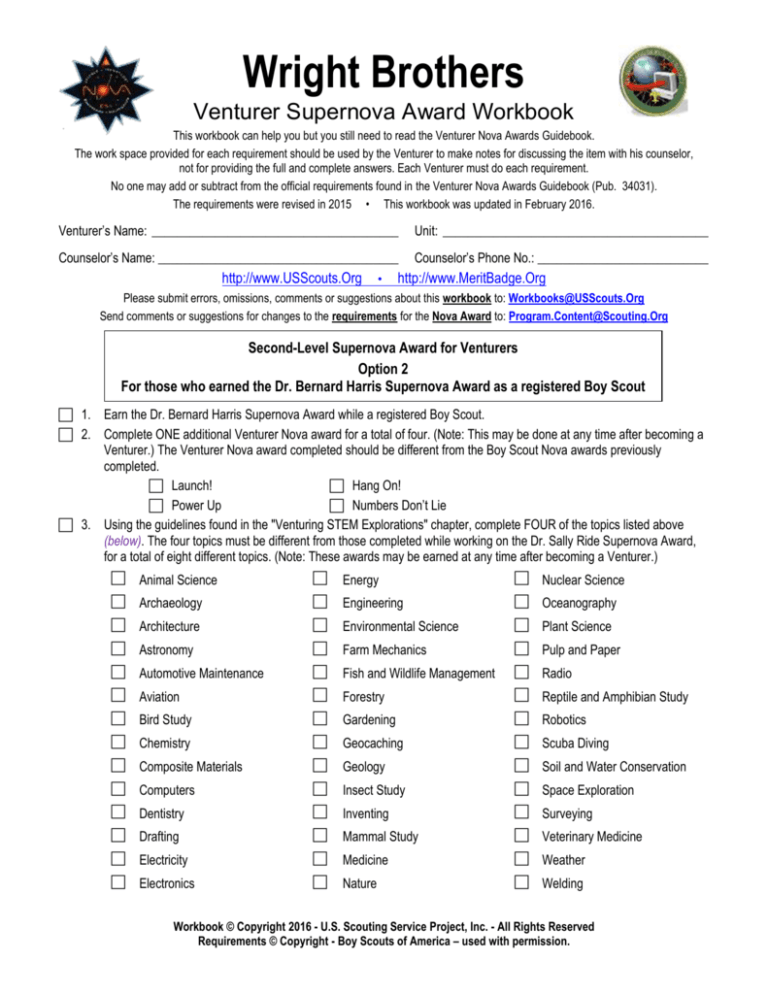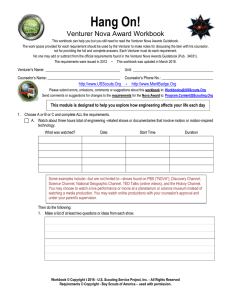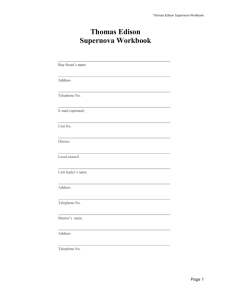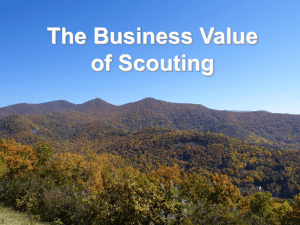
Wright Brothers
Venturer Supernova Award Workbook
This workbook can help you but you still need to read the Venturer Nova Awards Guidebook.
The work space provided for each requirement should be used by the Venturer to make notes for discussing the item with his counselor,
not for providing the full and complete answers. Each Venturer must do each requirement.
No one may add or subtract from the official requirements found in the Venturer Nova Awards Guidebook (Pub. 34031).
The requirements were revised in 2015 • This workbook was updated in February 2016.
Venturer’s Name: _______________________________________
Unit: __________________________________________
Counselor’s Name: ______________________________________
Counselor’s Phone No.: ___________________________
http://www.USScouts.Org
•
http://www.MeritBadge.Org
Please submit errors, omissions, comments or suggestions about this workbook to: Workbooks@USScouts.Org
Send comments or suggestions for changes to the requirements for the Nova Award to: Program.Content@Scouting.Org
Second-Level Supernova Award for Venturers
Option 2
For those who earned the Dr. Bernard Harris Supernova Award as a registered Boy Scout
1. Earn the Dr. Bernard Harris Supernova Award while a registered Boy Scout.
2. Complete ONE additional Venturer Nova award for a total of four. (Note: This may be done at any time after becoming a
Venturer.) The Venturer Nova award completed should be different from the Boy Scout Nova awards previously
completed.
Launch!
Hang On!
Power Up
Numbers Don’t Lie
3. Using the guidelines found in the "Venturing STEM Explorations" chapter, complete FOUR of the topics listed above
(below). The four topics must be different from those completed while working on the Dr. Sally Ride Supernova Award,
for a total of eight different topics. (Note: These awards may be earned at any time after becoming a Venturer.)
Animal Science
Energy
Nuclear Science
Archaeology
Engineering
Oceanography
Architecture
Environmental Science
Plant Science
Astronomy
Farm Mechanics
Pulp and Paper
Automotive Maintenance
Fish and Wildlife Management
Radio
Aviation
Forestry
Reptile and Amphibian Study
Bird Study
Gardening
Robotics
Chemistry
Geocaching
Scuba Diving
Composite Materials
Geology
Soil and Water Conservation
Computers
Insect Study
Space Exploration
Dentistry
Inventing
Surveying
Drafting
Mammal Study
Veterinary Medicine
Electricity
Medicine
Weather
Electronics
Nature
Welding
Workbook © Copyright 2016 - U.S. Scouting Service Project, Inc. - All Rights Reserved
Requirements © Copyright - Boy Scouts of America – used with permission.
Wright Brothers
Venturer’s Name: ________________________
4. Complete TWO additional Supernova activity topics, one each in the two STEM areas not completed for the Harris
Supernova Award. (Note: The intent is that upon completion of the Wright Brothers Supernova Award, the Venturer will
have completed one Supernova activity topic in each of the four STEM areas.)
STEM areas of topics previously completed (for the Dr. Bernard Harris Supernova Award)
Science
Technology
Engineering
Mathematics
STEM areas of topics completed for the Wright Brothers Supernova Award
Science
Technology
Engineering
Mathematics
5. Participate in a local, state, or national science fair or mathematics competition OR any other equally challenging STEMoriented competition or workshop approved by your mentor. An example of this would be an X-Prize type competition.
(Note: The intent is that upon completion of the Wright Brothers Supernova Award, the Venturer will have participated in
two such events.)
Competition:
Date:
6. Working with your mentor, organize and present a Nova awards or other STEM-related program at a Cub Scout den or
pack meeting. Be sure to receive permission from the appropriate unit leader. If a Cub Scout den or pack is not
available, your presentation may be given to another group. (Note: The intent is that upon completion of the Wright
Brothers Supernova Award, the Venturer will have completed two such presentations.)
Date:
Group:
Subject:
7. Research a scientific, technical, engineering, or mathematical breakthrough or invention of the past 100 years that has
affected our society in a meaningful way. Develop your hypothesis on how this invention might further affect our society
during your lifetime. Present either a 30-minute oral report or a 1,500-word written report to your mentor.
10. Submit an application to the district Nova or advancement committee for approval.
Wright Brothers – Supernova Award Workbook
Page 2 of 3
Attachment – (NOTE: It is not necessary to print this page.)
Important excerpts from the ‘Guide To Advancement’, No. 33088:
The ‘Guide to Advancement’ (which replaced the publication ‘Advancement Committee Policies and Procedures’) is the official
Boy Scouts of America source on advancement policies and procedures.
[ Inside front cover, and 5.0.1.4 ] — Unauthorized Changes to Advancement Program
No council, committee, district, unit, or individual has the authority to add to, or subtract from, advancement
requirements. (There are limited exceptions relating only to youth members with disabilities. For details see section 10,
“Advancement for Members With Special Needs”.)
[ Inside front cover, and 7.0.1.1 ] — The ‘Guide to Safe Scouting’ Applies
Policies and procedures outlined in the ‘Guide to Safe Scouting’, No. 34416, apply to all BSA activities, including those
related to advancement and Eagle Scout service projects. [Note: Always reference the online version, which is updated
quarterly.]
[ 7.0.3.1 ] — The Buddy System and Certifying Completion
Youth members must not meet one-on-one with adults. Sessions with counselors must take place where others can view
the interaction, or the Scout must have a buddy: a friend, parent, guardian, brother, sister, or other relative —or better
yet, another Scout working on the same badge— along with him attending the session. When the Scout meets with the
counselor, he should bring any required projects. If these cannot be transported, he should present evidence, such as
photographs or adult certification. His unit leader, for example, might state that a satisfactory bridge or tower has been
built for the Pioneering merit badge, or that meals were prepared for Cooking. If there are questions that requirements
were met, a counselor may confirm with adults involved. Once satisfied, the counselor signs the blue card using the date
upon which the Scout completed the requirements, or in the case of partials, initials the individual requirements passed.
[ 7.0.3.2 ] — Group Instruction
It is acceptable—and sometimes desirable—for merit badges to be taught in group settings. This often occurs at camp
and merit badge midways or similar events. Interactive group discussions can support learning. The method can also be
attractive to “guest experts” assisting registered and approved counselors. Slide shows, skits, demonstrations, panels,
and various other techniques can also be employed, but as any teacher can attest, not everyone will learn all the
material.
There must be attention to each individual’s projects and his fulfillment of all requirements. We must know that every
Scout —actually and personally— completed them. If, for example, a requirement uses words like “show,” “demonstrate,”
or “discuss,” then every Scout must do that. It is unacceptable to award badges on the basis of sitting in classrooms
watching demonstrations, or remaining silent during discussions. Because of the importance of individual attention in the
merit badge plan, group instruction should be limited to those scenarios where the benefits are compelling.
Page 3 of 3








